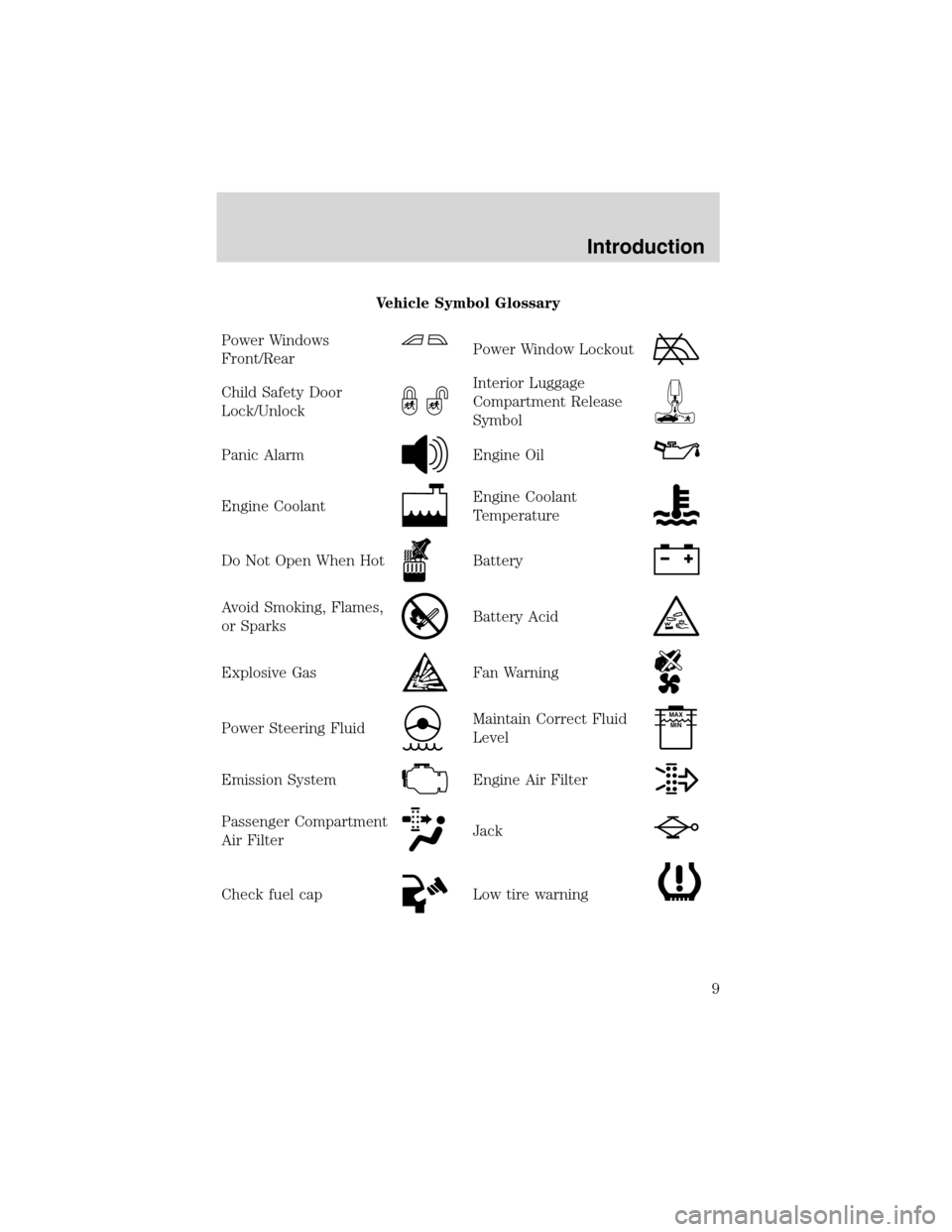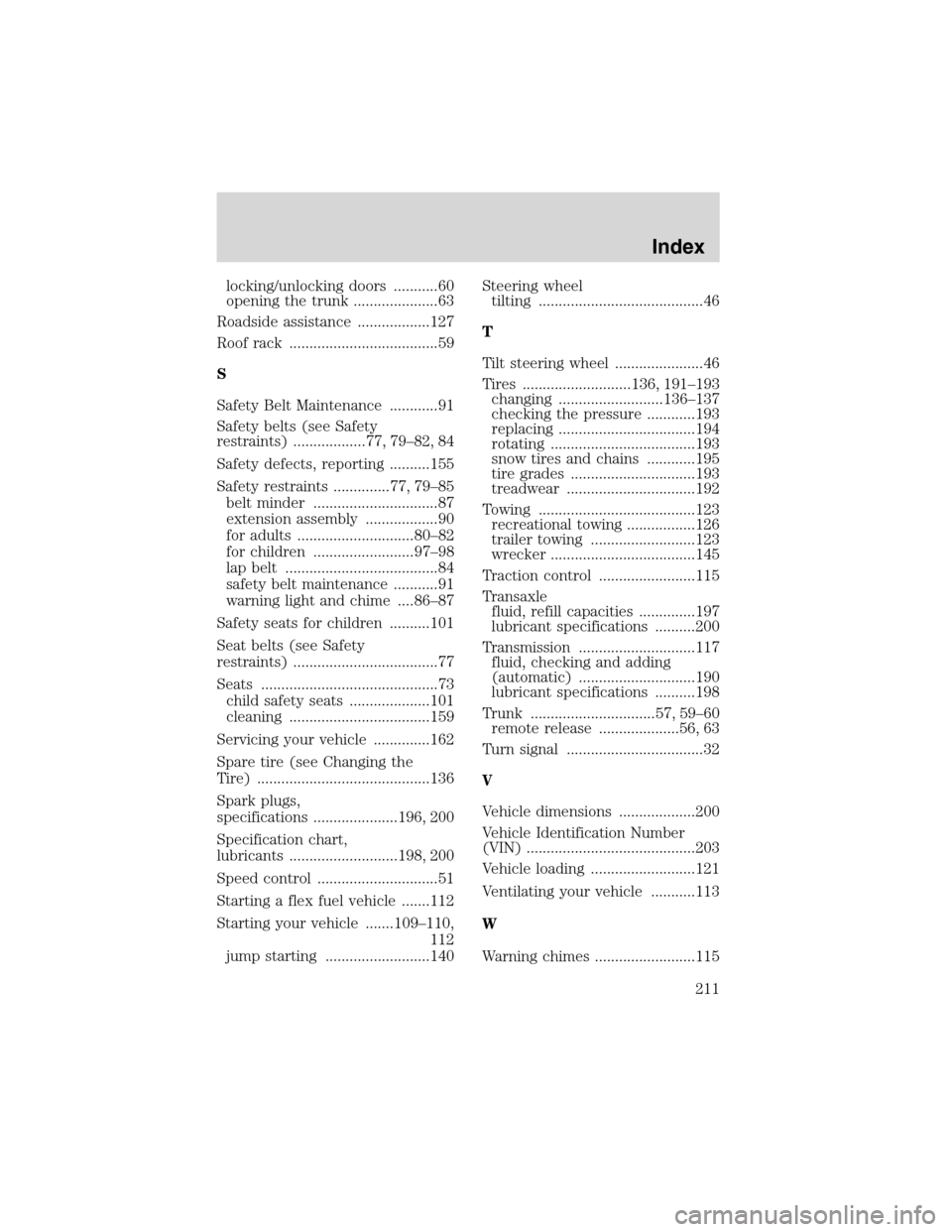fuel cap release Mercury Sable 2003 Owner's Manuals
[x] Cancel search | Manufacturer: MERCURY, Model Year: 2003, Model line: Sable, Model: Mercury Sable 2003Pages: 216, PDF Size: 1.66 MB
Page 9 of 216

Vehicle Symbol Glossary
Power Windows
Front/Rear
Power Window Lockout
Child Safety Door
Lock/UnlockInterior Luggage
Compartment Release
Symbol
Panic AlarmEngine Oil
Engine CoolantEngine Coolant
Temperature
Do Not Open When HotBattery
Avoid Smoking, Flames,
or SparksBattery Acid
Explosive GasFan Warning
Power Steering FluidMaintain Correct Fluid
LevelMAX
MIN
Emission SystemEngine Air Filter
Passenger Compartment
Air FilterJack
Check fuel capLow tire warning
Introduction
9
Page 171 of 216

When lifting a plastic-cased battery, excessive pressure on the
end walls could cause acid to flow through the vent caps,
resulting in personal injury and/or damage to the vehicle or battery.
Lift the battery with a battery carrier or with your hands on opposite
corners.
Keep batteries out of reach of children. Batteries contain sulfuric
acid. Avoid contact with skin, eyes or clothing. Shield your eyes
when working near the battery to protect against possible splashing of
acid solution. In case of acid contact with skin or eyes, flush
immediately with water for a minimum of 15 minutes and get prompt
medical attention. If acid is swallowed, call a physician immediately.
Battery posts, terminals and related accessories contain lead and
lead compounds.Wash hands after handling.
Because your vehicle’s engine is electronically controlled by a computer,
some control conditions are maintained by power from the battery. When
the battery is disconnected or a new battery is installed, the engine must
relearn its idle and fuel trim strategy for optimum driveability and
performance. To begin this process:
1. With the vehicle at a complete stop, set the parking brake.
2. Put the gearshift in P (Park), turn off all accessories and start the
engine.
3. Run the engine until it reaches normal operating temperature.
4. Allow the engine to idle for at least one minute.
5. Turn the A/C on and allow the engine to idle for at least one minute.
6. Release the parking brake. With your foot on the brake pedal and with
the A/C on, put the vehicle in D (Drive) and allow the engine to idle for
at least one minute.
7. Drive the vehicle to complete the relearning process.
•The vehicle may need to be driven 16 km (10 miles) or more to
relearn the idle and fuel trim strategy.
•If you do not allow the engine to relearn its idle trim, the idle
quality of your vehicle may be adversely affected until the idle
trim is eventually relearned.
If the battery has been disconnected or a new battery has been installed,
the clock and radio settings must be reset once the battery is
reconnected.
Maintenance and Specifications
171
Page 211 of 216

locking/unlocking doors ...........60
opening the trunk .....................63
Roadside assistance ..................127
Roof rack .....................................59
S
Safety Belt Maintenance ............91
Safety belts (see Safety
restraints) ..................77, 79–82, 84
Safety defects, reporting ..........155
Safety restraints ..............77, 79–85
belt minder ...............................87
extension assembly ..................90
for adults .............................80–82
for children .........................97–98
lap belt ......................................84
safety belt maintenance ...........91
warning light and chime ....86–87
Safety seats for children ..........101
Seat belts (see Safety
restraints) ....................................77
Seats ............................................73
child safety seats ....................101
cleaning ...................................159
Servicing your vehicle ..............162
Spare tire (see Changing the
Tire) ...........................................136
Spark plugs,
specifications .....................196, 200
Specification chart,
lubricants ...........................198, 200
Speed control ..............................51
Starting a flex fuel vehicle .......112
Starting your vehicle .......109–110,
112
jump starting ..........................140Steering wheel
tilting .........................................46
T
Tilt steering wheel ......................46
Tires ...........................136, 191–193
changing ..........................136–137
checking the pressure ............193
replacing ..................................194
rotating ....................................193
snow tires and chains ............195
tire grades ...............................193
treadwear ................................192
Towing .......................................123
recreational towing .................126
trailer towing ..........................123
wrecker ....................................145
Traction control ........................115
Transaxle
fluid, refill capacities ..............197
lubricant specifications ..........200
Transmission .............................117
fluid, checking and adding
(automatic) .............................190
lubricant specifications ..........198
Trunk ...............................57, 59–60
remote release ....................56, 63
Turn signal ..................................32
V
Vehicle dimensions ...................200
Vehicle Identification Number
(VIN) ..........................................203
Vehicle loading ..........................121
Ventilating your vehicle ...........113
W
Warning chimes .........................115
Index
211